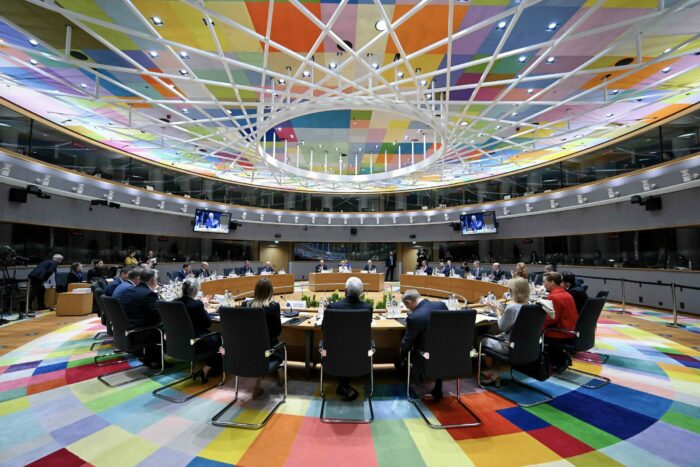Find all related Progressive Post
Progressive Post

The delays in the supply of Western weapons, exacerbated by a deadlock in the US over the approval of the aid to Ukraine, have introduced a sense of urgency for Ukraine to mobilise its internal resources for military production. Moreover, as the hopes for a swift victory have faded and the spectrum of a protracted war has become evident, the question of transforming the Ukrainian economy to a war model becomes imperative.
It is stunning, but after two years of war, the Ukrainian economy has not (yet) become a war economy. The central bank and the government have implemented a range of measures, but their scope and size remain insufficient for the war challenge. State defence expenses increased several times but are still below the needs of the army and available production capacity. According to estimates, only half of the capacity of the defence industry was used in 2023. There are objective reasons for the weak production, like the destruction of some production sites and shortages of workers. But the low volume of state procurement is the major impediment.
The truth is that the Ukrainian state does not have enough money to finance defence procurement. This limitation, however, is partially self-inflicted and there are various resources that can be mobilised. More alignment of the monetary policy with the needs of the war would be particularly helpful. The Ukrainian central bank (NBU) was very effective at the beginning of the war when it introduced a range of emergency measures that prevented a banking and currency meltdown (notably, capital and FX controls). Its later policies, however, were less supportive of the war economy. In June 2022, the central bank massively increased its main policy rate from 10 per cent to 25 per cent, motivating it by the need to contain inflation. On top of it, the NBU has tied the rate of remuneration of bank liquidity (the so-called deposit certificates) at minus two per cent points of the policy rate, so that banks could get risk-free 23 per cent on their liquidity. Logically, they were not eager to lend to business at rates lower than that, while business was not prepared to pay such exorbitant rates. This was one of the main reasons behind the stagnation in bank lending: the outstanding stock of bank loans to businesses declined from 19 per cent of GDP as of March 2022 to 14 per cent as of November 2023. The only corporate lending that was happening was subsidised loans under a government-sponsored programme (the so-called ‘5-7-9’ programme). Corporate lending started to gradually revive only in the second half of 2023. In the meantime, banks accumulated massive amounts of liquidity sitting in the central bank – 720 billion Ukrainian Hryvni (17,6 billion Euro) as of February 2024.
The high-interest rates on liquidity also discouraged banks from investing in government bonds. After the rate increase, banks almost stopped buying government bonds in the summer of 2022. The central bank had strongly encouraged the Ministry of Finance to increase rates on government bonds. These rates eventually increased from 10.3 per cent in May 2022 to 17.3 per cent by the end of 2022 and were in the vicinity of 19 per cent for most of 2023 (see the chart). Consequently, the government faced a much higher cost of servicing its domestic debt: in 2023, it spent 200 billion UAH (3.6 per cent of GDP) on interest payments on its domestic bonds.
The policy of high remuneration for bank liquidity also led to a substantial reduction in the amount of central bank profits that was transferred to state budget. In 2023, banks received 92 billion Ukrainian Hryvni (2.3 billion Euro) of income from deposit certificates, the equivalent of 1.7 per cent of GDP. This is what could have been the government income. After the deposit certificates became a matter of public discussion, the central bank introduced a windfall profit tax of 50 per cent on banks’ excessive profits, which they had to pay on their 2023 profits. This is a welcome step, but stopping the whole scheme of liquidity remuneration would be a much better solution.
The biggest elephant in the room, however, is the monetary financing of the deficit. In Ukrainian policy circles, it is taboo, not without pressure from foreign partners, notably the IMF. During the first months of the war, the NBU did such financing but stopped as soon as foreign aid started coming. It is not quite understandable why Ukraine is discouraged from using monetary financing when it was widely used by other countries when they fought wars (for example, the UK, during the Second World War, had 61 per cent of its budget financed this way). The usual objection is that it can be inflationary or lead to devaluation. Yet, there are answers to that: Singapore, for example, learning from the Keynesian policies deployed in the UK during and after WW2, has established a very effective system that allows for monetary deficit financing without currency destabilisation (see the article of Artem Gergun).
To sum up, there is lots of room for finding domestic resources for financing the war and reinvigoration of the economy. For that, the central bank should be on board with the war effort and should:
The Ukrainian policy space is very charged now, as the economic needs of the war are not being fulfilled. President Volodymyr Zelensky has questioned the possibility of mobilising an additional 500,000 soldiers, as the army had requested, which would cost circa 700 billion UAH. The ambition of the military to switch to a high-tech war also requires substantial financing. Ukraine has come to a point where it cannot successfully wage a war if it does not switch its economy into war mode.
Photo credits: Shutterstock.com/Skorzewiak
| Cookie | Duration | Description |
|---|---|---|
| cookielawinfo-checkbox-advertisement | 1 year | Set by the GDPR Cookie Consent plugin, this cookie is used to record the user consent for the cookies in the "Advertisement" category . |
| cookielawinfo-checkbox-analytics | 11 months | This cookie is set by GDPR Cookie Consent plugin. The cookie is used to store the user consent for the cookies in the category "Analytics". |
| cookielawinfo-checkbox-functional | 11 months | The cookie is set by GDPR cookie consent to record the user consent for the cookies in the category "Functional". |
| cookielawinfo-checkbox-necessary | 11 months | This cookie is set by GDPR Cookie Consent plugin. The cookies is used to store the user consent for the cookies in the category "Necessary". |
| cookielawinfo-checkbox-others | 11 months | This cookie is set by GDPR Cookie Consent plugin. The cookie is used to store the user consent for the cookies in the category "Other. |
| cookielawinfo-checkbox-performance | 11 months | This cookie is set by GDPR Cookie Consent plugin. The cookie is used to store the user consent for the cookies in the category "Performance". |
| csrftoken | past | This cookie is associated with Django web development platform for python. Used to help protect the website against Cross-Site Request Forgery attacks |
| JSESSIONID | session | The JSESSIONID cookie is used by New Relic to store a session identifier so that New Relic can monitor session counts for an application. |
| viewed_cookie_policy | 11 months | The cookie is set by the GDPR Cookie Consent plugin and is used to store whether or not user has consented to the use of cookies. It does not store any personal data. |
| Cookie | Duration | Description |
|---|---|---|
| __cf_bm | 30 minutes | This cookie, set by Cloudflare, is used to support Cloudflare Bot Management. |
| S | 1 hour | Used by Yahoo to provide ads, content or analytics. |
| sp_landing | 1 day | The sp_landing is set by Spotify to implement audio content from Spotify on the website and also registers information on user interaction related to the audio content. |
| sp_t | 1 year | The sp_t cookie is set by Spotify to implement audio content from Spotify on the website and also registers information on user interaction related to the audio content. |
| Cookie | Duration | Description |
|---|---|---|
| CONSENT | 2 years | YouTube sets this cookie via embedded youtube-videos and registers anonymous statistical data. |
| iutk | session | This cookie is used by Issuu analytic system to gather information regarding visitor activity on Issuu products. |
| s_vi | 2 years | An Adobe Analytics cookie that uses a unique visitor ID time/date stamp to identify a unique vistor to the website. |
| Cookie | Duration | Description |
|---|---|---|
| NID | 6 months | NID cookie, set by Google, is used for advertising purposes; to limit the number of times the user sees an ad, to mute unwanted ads, and to measure the effectiveness of ads. |
| VISITOR_INFO1_LIVE | 5 months 27 days | A cookie set by YouTube to measure bandwidth that determines whether the user gets the new or old player interface. |
| YSC | session | YSC cookie is set by Youtube and is used to track the views of embedded videos on Youtube pages. |
| yt-remote-connected-devices | never | YouTube sets this cookie to store the video preferences of the user using embedded YouTube video. |
| yt-remote-device-id | never | YouTube sets this cookie to store the video preferences of the user using embedded YouTube video. |
| yt.innertube::nextId | never | This cookie, set by YouTube, registers a unique ID to store data on what videos from YouTube the user has seen. |
| yt.innertube::requests | never | This cookie, set by YouTube, registers a unique ID to store data on what videos from YouTube the user has seen. |
| Cookie | Duration | Description |
|---|---|---|
| COMPASS | 1 hour | No description |
| ed3e2e5e5460c5b72cba896c22a5ff98 | session | No description available. |
| loglevel | never | No description available. |


